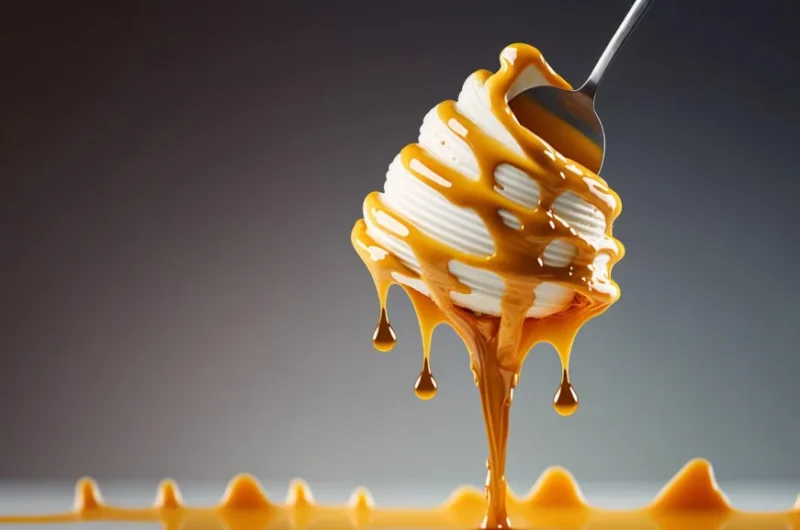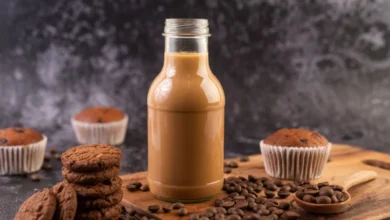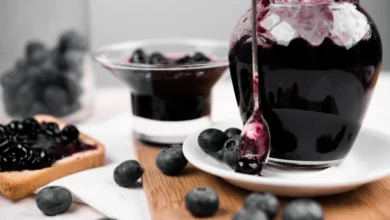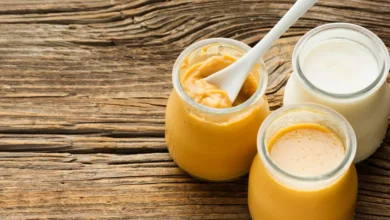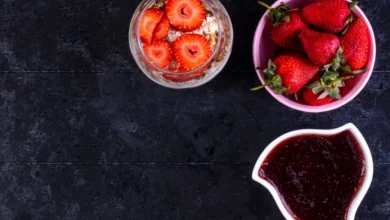Heavenly Creamy Butterscotch Sauce Enhances Any Dessert

This incredibly simple butterscotch sauce recipe only requires 5 ingredients and around 6 minutes to make. As an avid baker who enjoys researching and trying traditional recipes from the interwebs, I was looking for a way to make my own butterscotch sauce at home rather than purchasing a store-bought version. My searches led me to discover this Easy Butterscotch Sauce, which produces a silky smooth sauce to top desserts like ice cream, tarts, pies, and cakes or cupcakes with its delicious flavors. The recipe calls for just butter, brown sugar, heavy cream, and a pinch of salt.
Once the ingredients are brought together and cooked for 6 minutes, you are left with the most incredible fabulous, rich butterscotch sauce. I love using it for swirling and drizzling purposes. A quick swirl of butterscotch adds an extra layer of indulgence to homemade ice cream or gelato. It also bakes up nicely in brownies for bursts of butterscotch flavor throughout. Keeping an extra container in the fridge means this homemade butterscotch sauce is always ready to enhance my desserts. The versatility of this sauce is why it has become a staple in my kitchen.
Contents
- Homemade Butterscotch Sauce:
- What is Butterscotch?
- Tools For Butterscotch Sauce:
- Ingredients
- How to Make Butterscotch Sauce?
- How To Store And Reheat Butterscotch Sauce?
- Tips For Making The Best Butterscotch Sauce:
- Why Avoid Ultra-Pasteurized Cream?
- What Kind Of Cream Should I Use?
- How Do I Prevent Butterscotch Sauce From Curdling?
- What’s The Difference Between Butterscotch And Caramel?
- Troubleshooting Tips:
- How to Use this Sweet Confection?
- Café Tips for Making Butterscotch Sauce:
- Frequently Asked Questions
- What is butterscotch sauce made of?
- What is the main ingredient in butterscotch?
- Is butterscotch just butter and scotch?
- Is butterscotch just vanilla and caramel?
- Does scotch ever taste like butterscotch?
- What flavor is closest to butterscotch?
- What liquor tastes like butterscotch?
- What is whiskey called before it’s aged?
- How to make a butterscotch recipe without cream?
- What is an old fashioned butterscotch recipe?
- Creamy Butterscotch Sauce
Homemade Butterscotch Sauce:
The process of making this homemade butterscotch sauce could not be easier. Simply combine the butter, brown sugar, heavy cream and salt in a saucepan. Cook while whisking continuously for just 6 minutes as the ingredients melt and blend into a smooth, luscious sauce.
The aromas of caramelized sugar and warm butter that fill the kitchen as it simmers are incredibly appetizing. Once cooled, the sauce has a thick, spoonable texture that clings beautifully to anything it touches. Its silky coating and rich butterscotch flavor impart indulgent delight to every dessert it enhances.
What is Butterscotch?
Historically, butterscotch started as a type of hard candy made without refined or unprocessed sugar. The suffix “-scotch” means “to cut,” referring to the method of scoring and breaking the candy into pieces. A Scottish confectioner would warm and gently score the candy blocks to facilitate clean breaking along the scored edges.
Today, butterscotch conjures thoughts of its flavor – a complex blend of caramel richness with notes of butter. It became most famous at early 20th century American soda fountains, often accompanying treats like banana splits. Its sauce counterpart gained popularity in American desserts and snacks throughout the 1950s.
Butterscotch pudding and candies were among households’ favorite sweet indulgences. In more recent years, authentic butterscotch flavors are less readily available as many products rely on artificially flavored imposters that cast a shadow of doubt. This easy homemade butterscotch sauce recipe provides hope to recapture those memorable flavors without compromise.
Tools For Butterscotch Sauce:
- Measuring cups – For accurately measuring the butterscotch sauce ingredients
- Measuring spoons – To precisely measure smaller amounts like salt
- Saucepan – A medium saucepan for heating and cooking the butterscotch sauce
- Silicone spatula – For smooth scraping and stirring of the sauce ingredients
- Container – A jar or other airtight container for storing the cooled butterscotch sauce
Ingredients
| Ingredients | Amount |
| Brown sugar | 1 cup |
| Butter | 1/2 cup (1 stick) |
| Heavy cream | 1 cup |
| Vanilla | 1 teaspoon |
| Salt | 1/4 teaspoon kosher salt or regular salt |
This simple recipe only requires 5 basic ingredients to create a wonderfully caramel-like sauce. Using brown sugar as the base brings robust molasses notes. Butter adds its signature richness and creaminess. Heavy cream provides texture and silkiness when blended together. A hint of vanilla enhances the other flavors. A small amount of salt helps bring out the other flavors, so you can trust this recipe to deliver maximum butterscotch savoriness.
How to Make Butterscotch Sauce?
In a medium saucepan, combine the butter, 1 cup brown sugar and 1/4 teaspoon salt. Heat the mixture over medium, stirring constantly, until the butter is melted, and the sugars start to melt and bubble, about 3–5 minutes. Slowly pour in 1 cup heavy cream, still whisking constantly. Allow the mixture to come to a simmer, then reduce heat to low and let the sauce simmer for 2–4 minutes, stirring occasionally, until thickened slightly. Remove from heat and stir in 1 teaspoon vanilla. Allow the sauce to sit and cool for 15 minutes, stirring a few times.
Store the cooled butterscotch sauce in an airtight jar or container in the fridge for up to 2 weeks. Reheat over low heat until pourable or warm before using as a topping. Enjoy warm over ice cream, drizzled over cakes or pound cake, or simply with a spoon! The flavors will transport you straight to butterscotch bliss.
How To Store And Reheat Butterscotch Sauce?
For long term storage, the sauce can be frozen in an airtight container for up to 3 months. Allow it to fully thaw in the refrigerator before reheating. When reheating in the microwave, heat in short bursts of 5–10 seconds, stirring between each burst. This helps prevent scorching.
Reheating the sauce over low, gentle heat on the stove top is safer than high microwave power if you want to avoid scorching. Stir frequently as it warms. No matter the reheating method, don’t allow the sauce to come to a full boil. You just want to warm it through until it reaches a pourable consistency.
For optimum flavor, try to use refrigerated butterscotch sauce within 2 weeks. It may begin to lose some brightness if stored longer. When serving, drizzle or dollop butterscotch sauce while still warm so it has a fluid, luxurious texture for oozing over ice cream and other desserts. Refrigerate any leftovers immediately in an airtight container. Reheat small portions at a time to keep quality high with multiple uses.
Tips For Making The Best Butterscotch Sauce:
- For a deeper, richer butterscotch flavor, substitute half the brown sugar called for with Truvia brown sugar or another brand of sugar substitute. This adds molasses notes without excess sugar.
- Aim for a nice golden brown color when cooking the butter and sugars. Remove from heat once it reaches this caramelized shade for maximum flavor impact.
- Demerara sugar’s large crystal texture enhances butterscotch’s signature chewiness. Try substituting 1/4 cup for an indulgent texture twist.
- Heavy cream gives a lush, spoon-coatable texture, but you can also use table cream, double cream or heavy whipping cream depending on preferred thickness.
- For a slightly thinner pouring consistency, substitute 1/4 cup of the cream with milk.
- Doubled batches of sauce freeze beautifully for months. Simply store portioned sauce in an airtight container in the freezer until ready to rewarm.
- Rewarm frozen butterscotch sauce in the fridge overnight or in a saucepan with a splash of water until pourable.
- High quality salted butter intensifies flavor compared to unsalted. A touch of salt balances the natural flavor.
Why Avoid Ultra-Pasteurized Cream?
It’s best to use heavy cream that has not gone through the ultra-pasteurization process when making homemade butterscotch sauce. Cream that is ultra-pasteurized contains added stabilizers that can impart slightly bitter flavors into certain recipes.
For butterscotch sauce, look for heavy cream found in the dairy section of most health food stores, local grocers like Trader Joe’s, and natural markets. Traditionally pasteurized cream has superior taste and flavor.
The ultra-pasteurization process exposes cream to higher temperatures for longer periods of time than conventional pasteurization. This extends shelf life significantly but can negatively impact the fresh, nuanced cream flavor that homemade butterscotch sauce strives for.
When possible, seek out heavy cream from smaller farms that use traditional pasteurization methods. It makes a noticeable difference in the flavor of this beloved homemade butterscotch sauce.
What Kind Of Cream Should I Use?
There are a few different types of cream that can work in butterscotch sauce recipes, but some are better than others. Opt for cream with the highest fat content and fewest additives. Dairy cream (18-30% fat) is thinner than heavy cream but will still yield good results. Heavy cream (36-40% fat) is ideal as its richness balances the butterscotch flavors beautifully.
Whipping cream is often ultra-pasteurized and contains thickeners, so best to avoid. Half-and-half and light cream are too thin for properly thickening the sauce. Look for cream in the refrigerated section marked as natural cream without gums or stabilizers added.If necessary, you can use milk diluted with an additional 1-2 tbsp butter for richness. But cream is most authentic.
For the smoothest, creamiest butterscotch sauce, opt for heavy cream that contains only milk and has the highest fat ratio. Its natural richness can’t be beat.
How Do I Prevent Butterscotch Sauce From Curdling?
There are a few key steps to take to avoid Homemade Butterscotch Sauce from curdling or crystallizing:Use a heavy bottom saucepan to ensure even cooking without hot spots. Heat the butter and sugar mixture over medium-low heat, stirring constantly and evenly. This prevents uneven temperature changes.Bring the cream to a simmer slowly over medium temperature to allow gradual blending.
Don’t allow the sauce to boil rapidly, as rapid temperature changes can cause curdling. Remove from heat before adding cream and let stir to a gentle simmer before removing from heat completely.
Additions like vanilla should be stirred right after removal from heat to maintain even consistency. Taking time to combine and cook ingredients consistently at moderate heat levels helps create a smooth, perfectly curdling-free homemade butterscotch sauce. Go slow for best results.
What’s The Difference Between Butterscotch And Caramel?
| Butterscotch | Caramel |
| Uses brown sugar containing molasses | Uses plain white sugar |
| Has distinctive molasses flavor profile | Lacks molasses for a purer, butter-like taste |
| Tends to be slightly more stickier and nuttier | Crisper and less sticky texture |
| Cooking process retains some sugar granules | Cooked longer until very dark color |
| Signature taste from brown sugar ingredient | Flavor solely from sugar caramelization |
| Sought for those wanting flavor beyond a basic caramel | Provides a more straightforward unique flavor profile |
| Needs brown sugar kept in the pantry | Plain white sugar most common ingredient |
In summary, the key flavor and textural differences between butterscotch and caramel arise from butterscotch’s inclusion of molasses-rich brown sugar in its recipe versus caramel relying solely on the caramelization of plain white sugar for taste.
Troubleshooting Tips:
- If the brown sugar is not fully melting, reduce the heat slightly and stir frequently to prevent scorching or burning.
- Watch carefully as the butter and sugars are cooking and heating to avoid allowing the mixture to burn.
- For a thicker, saucier consistency, continue cooking the butterscotch mixture for a few extra minutes after the sugars have fully dissolved.
- Stir constantly while cooking to ensure even melting and prevent burning on the bottom of the pan.
- If the sauce does not seem to be thickening enough, simmer for a few minutes longer over low heat while stirring constantly.
- Remove from heat immediately if burning occurs and start again with fresh ingredients. No burnt butterscotch sauce salvaging!
Being vigilant while cooking and melting the key brown sugar ingredient is crucial to butterscotch sauce success. Go slowly for best results.
How to Use this Sweet Confection?
Once made, this easy butterscotch confection becomes a divine dessert building block. Its silky-smooth and richly hued texture pairs perfectly with myriad sweets.. For example, consider brushing warm salted butterscotch sauce over fresh-baked cookies or waffles.
Butterscotch sauce also makes an indulgent cake topping or filling. One elegant use is to drizzle or pipe the sauce artistically over slices of yellow cake or spice cake still warm from the oven. The heat helps the sauce soak slightly into the crumb without becoming soggy. For an especially decadent treat, fill the center of individual cake servings with a generous scoop of vanilla ice cream before gilding with more butterscotch sauce. No matter the application, this sauce contributes unparalleled indulgence to any sweet it adorns, making it a perfect accessory for cakes both casual and celebratory.
- Dollop over vanilla ice cream for an instant royal dessert fit for deliciousness.
- Spread between two shortbread cookies for handheld bliss.
- Swirl into apple desserts, pumpkin pie or crisps for take their flavor profiles to new heights.
- Brush warm over fresh-baked waffles or cookie bars still in their baking pans.
- Drizzle spirals onto plated pears or poached fruit for an eye-catching photo worthy dish.
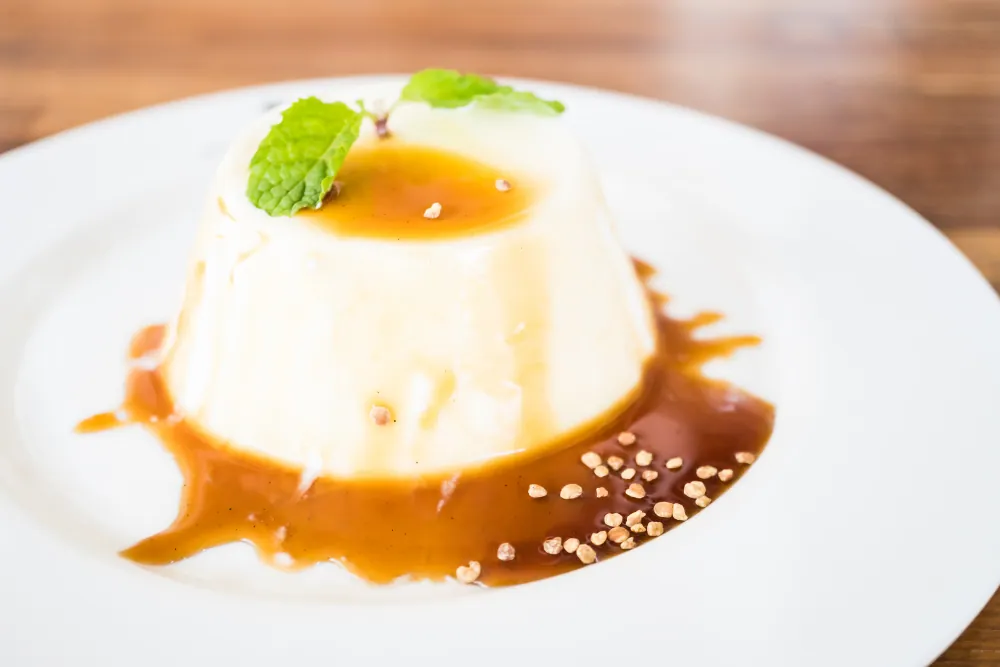

Once refrigerated, the sauce can be easily reheated without boiling or simmering. Simply warm in a saucepan until pourable but not grainy. Store leftover sauce in an airtight container in the refrigerator for up to 2 weeks. Simply reheat small scoops as desired for serving. Its buttery-sweet , drizzle-able texture pairs with seemingly everything! Be creative and enjoy this simple cooking process ‘luscious rewards.
RELATED: Fresh Raspberry Sauce
RELATED: Fresh Strawberry Sauce
Café Tips for Making Butterscotch Sauce:
- For the deepest, richest flavor use the darkest brown sugar available such as Laura Lynn or Dixie Crystals Dark Brown Sugar. Its intense hue makes for a vibrant sauce.
- Local store brand dark brown sugars also work well but compare ingredient labels for least processed variety.
- Use dark rather than light brown sugar for optimum flavor impact in this sauce.
- Finishing touches of Maldon flake salt from England add crunch and depth of flavor . Its large crystals melt elegantly on the tongue.
- For a clean, mild tasting salt that won’t overwhelm other flavors, use kosher salt. Avoid iodized table salt which can add unwanted bitterness.
- Store leftover sauce in an airtight container in the refrigerator or freezer for up to 6 months. Simply reheat in a saucepan or carefully in the microwave until pourable.
- Prevent crystallization by stirring in a tablespoon of lemon juice. This promotes chemical inversion keeping the sauce from becoming grainy.
- Consider gifting this easy-to-make sauce in small Weck Mini Tulip Jars alone or paired with other holiday gifts like jams, jellies or in our customer favorite Salted Butterscotch Panna Cotta.
Enjoy on meats, vegetables and of course desserts for an elegant final flavor touch worthy of any sophisticated city café counter.
Conclusion
While simple to make, butterscotch sauce offers rich, complex flavors that have made it a classic dessert staple for generations. The mellow sweetness from brown sugar and cream coupled with the indulgent butteriness is truly hard to resist. Whether enjoyed straight off a spoon, drizzled over ice cream or paired with fall fruit crisps, this luscious sauce adds an elegant touch of sophistication. Its versatility allows it to complement both savory and sweet dishes alike.
Frequently Asked Questions
What is butterscotch sauce made of?
Butterscotch sauce is made of butter, brown sugar, heavy cream, and vanilla. The brown sugar provides a robust molasses flavor.
What is the main ingredient in butterscotch?
The two main ingredients in butterscotch are brown sugar and butter. The brown sugar contributes its characteristic molasses notes while the butter adds richness.
Is butterscotch just butter and scotch?
No, butterscotch does not actually contain scotch whisky. The name is thought to come from “butter” and the old English word “scotch” meaning “to cut”. It refers to the grainy texture from brown sugar.
Is butterscotch just vanilla and caramel?
Butterscotch has its own unique flavor profile that is different from both vanilla and caramel. Its signature molasses flavor comes from the use of brown sugar rather than just caramelizing white sugar.
Does scotch ever taste like butterscotch?
While scotch and butterscotch share some similar butter and caramel flavors, scotch has its own smokey, peaty flavors that are not predominant in butterscotch.
What flavor is closest to butterscotch?
Buttery toffee and fudge flavors are probably the closest comparisons to the rich butteriness and molasses notes of butterscotch, though its flavor is truly its own.
What liquor tastes like butterscotch?
No liquor explicitly tastes of butterscotch, though some scotches like Drambuie or butterscotch schnapps can have complementary flavor profiles.
What is whiskey called before it’s aged?
Unaged whiskey is called white dog or moonshine before being barreled and taking on flavors from aging and wood.
How to make a butterscotch recipe without cream?
One common question is whether cream is required in a butterscotch sauce recipe. Here is a recipe for butterscotch sauce without cream:
Melt 1 cup butter with 2 cups brown sugar over low heat, stirring frequently, until thickened, about 15-20 minutes. Remove from heat and whisk in 1/2 cup evaporated milk and 1 tsp vanilla extract until smooth. This version uses evaporated milk in place of cream for a dairy-free alternative.
What is an old fashioned butterscotch recipe?
This basic butterscotch sauce recipe provides the classic flavor profile. For those seeking an old fashioned version rooted in tradition, try:
Use dark brown sugar rather than light, as the deeper molasses notes result in a more nostalgic butterscotch flavor. Long simmer the brown sugar and butter mixture until very thickened, about 30 minutes, for an intensely rich yet smooth sauce reminiscent of grandma’s pantry. This old-fashioned butterscotch sauce recipe relies on letting its few traditional ingredients shine without unnecessary adjustments.
Creamy Butterscotch Sauce
Course: Sauce PairingsCuisine: American2
servings5
minutes8
minutes185
kcal13
minutesA comforting classic, this easy butterscotch sauce is creamy dreamy sweetness in a bowl. Melt buttery brown sugar into heavenly caramel, whisk in heavy cream for velvety softness. Chill for a luscious topping to pies, ice cream or fruit. Warm also to drizzle on waffles. Kids and adults alike love this richly sweet bite of indulgence.
Ingredients
Brown sugar 1 cup
Vanilla 1 teaspoon
Heavy cream 1 cup
Butter 1/2 cup (1 stick)
Salt 1/4 teaspoon kosher salt or regular salt
Directions
- Combine butter, brown sugar and salt in saucepan. Heat until melted.
- Slowly pour in heavy cream, whisking constantly.
- Simmer for 2-4 minutes until thickened.
- Remove from heat and stir in vanilla.
- Cool before storing in fridge for up to 2 weeks. Enjoy!

